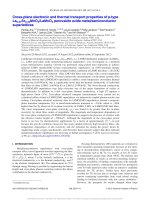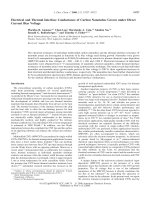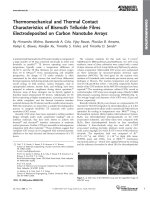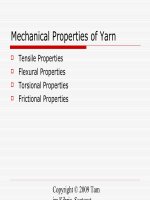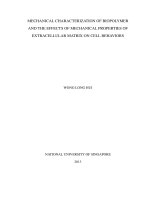Preparation, morphology and thermal mechanical properties of epoxy nanoclay composites
Bạn đang xem bản rút gọn của tài liệu. Xem và tải ngay bản đầy đủ của tài liệu tại đây (6.45 MB, 163 trang )
Preparation, Morphology and Thermal/Mechanical
Properties of Epoxy-Nanoclay Composites
WANG LEI
(B. Sci, University of Science & Technology of China)
A THESIS SUBMITTED
FOR THE DEGREE OF PH. D OF PHILOSOPHY
DEPARTMENT OF MATERIALS SCIENCE
NATIONAL UNIVERSITY OF SINGAPORE
2005
Acknowledgement
I would like to express my deepest gratitude to my supervisors, Dr He Chaobin and Dr
Zhang Yongwei, for their continuous care and guidance in the past years. Their advices
will be great fortune to me in my future career and life.
It’s my pleasure to give my great thanks to all staff and students in IMRE for their help in
my work. My hearty appreciation should be given to Dr Liu Tianxi and Dr Wang Ke for
discussions and advices in my research. My special thanks are given to Mr Chen Ling,
Mr In Yee, Ms Wuiwui and Ms Shen Lu, for their assistance in preparation and
characterization of materials. I would also like to show my sincere thanks to Mr Zhao
Wei, Mr Poh Chong, Ms Shue Yin and Ms Doreen for their help in experiment.
I want to show my acknowledgement to National University of Singapore and Institute of
Material Research and Engineering for providing me with the opportunity to pursue my
Ph. D degree as well as facilities to conduct my research.
I am indebted to my wife and parents. Their support and encouragement are important for
me to finish this thesis.
I
Table of contents
Acknowledgement……………………………………………………………………….I
Table of contents………………………… …… ………….……………………… II
Summary……………………………….……… ………….…… ………………… VI
List of tables…………………………… ……… ………… ………… ……………IX
List of figures……………………………… …… ………….……… … ………… X
List of symbols……………………………….……… ………….…… … …….… XIV
List of publications……………………………… …… …………… … ………….XV
Chapter 1 Introduction…………………………………… …………… …………….1
Chapter 2 Development of polymer-nanoclay composites……….……… …… ……….7
2.1 Background….………………………………… …………………………….7
2.1.1 Clay information…………………………………… … ………….8
2.1.1.1 Structure of clay……………………………… … ….….8
2.1.1.2 Clay surface modification and organoclay structures……10
2.1.1.3 Synthetic organoclay……………… ………………… 12
2.1.2 Properties of polymer-clay nanocomposites…………………… 13
2.1.2.1 Tensile properties………………………… …………….13
2.1.2.2 Fracture…………………………………… ………… 15
2.1.2.3 Dynamic mechanical properties………………………….16
2.2 Synthesis of polymer-layered silicate nanocomposites……………… …….20
2.2.1 In-situ polymer-clay nanocomposite……………………… …… 22
2.2.2 Solution intercalation………………………………………………23
II
2.2.3 Melt intercalation……………………………… ……………… 24
2.3 Polymer-clay nanocomposites…………………………………… ……… 25
2.3.1 Thermoplastic-clay nanocomposites…………………… ………26
2.3.2 Thermoset-clay nanocomposites…………………………….….….36
2.4 Conclusions and our proposed work…………………………………….… 46
Chapter 3 Materials and experiment……………………………………………….…….54
3.1 Materials…………………………………………………….………….… 54
3.2 Preparation of epoxy-clay nanocomposites…………………….…….….… 57
3.2.1 Benchmark organoclay system………………………….….…… 57
3.2.2 Microwave-assisted pristine clay system………………….…….…57
3.2.3 Solvent-assisted silane-modifided clay (SMC) system…………….57
3.3 Nanocomposite characterization………………………………………… …57
3.3.1 Optical microscopy (OM)………………………………… …… 58
3.3.2 Wide angle X-ray scattering (WAXS)……………………… … 58
3.3.3 Transmission electron microscopy (TEM) analysis…………… 60
3.4 Fourier transform infrared (FTIR) spectroscopy…………………………….61
3.5 Time-of-flight secondary ion mass spectrum (ToF-SIMS)…… … ….…61
3.6 Mechanical test……………………………………………….………….… 61
3.7 Scanning electron microscopy (SEM)……………………………… …… 63
3.8 Dynamic mechanical analysis (DMA)………………………………… … 64
Chapter 4 Benchmark organoclay system……………………………………………… 65
4.1 Background……………………………………………………………… 65
4.2 Preparation of epoxy-clay nanocomposites…………………………….……65
III
4.3 Morphology………………………………………… ………………………66
4.4 Thermal properties……………………………………… ………………….70
4.5 Mechanical properties……………………………………… ………….… 72
4.5.1 Tensile properties…………………… …………… ……….… 72
4.5.2 Fracture toughness……………………………………… ……… 75
4.6 Morphologies of fracture surfaces by SEM…………………………… … 77
4.7 Summary…………………………………………………………………… 80
Chapter 5 Microwave-assisted pristine clay system……………………………….…….83
5.1 Background……………………………………………………… …………83
5.2 Preparation of epoxy-raw clay nanocomposites…………………… ………83
5.3 Exfoliation mechanism and morphology of pristine clay……………… … 84
5.4 Thermal properties………………………………………………………… 92
5.5 Mechanical properties……………………………………………………… 94
5.5.1 Tensile properties……………………… ……………………… 94
5.5.2 Fracture toughness………………………… …………………… 96
5.6 SEM morphology of the fracture surface………………… ……………… 98
5.7 Summary……………………………………………………………… … 101
Chapter 6 Solvent-assisted silane-modified clay system……………………… …… 104
6.1 Process and mechanisms………………… …………………………….….104
6.1.1 Background………………………… ………………………… 104
6.1.2 Sample preparation…………………… ……………………… 104
6.1.3 A “hydro-compounding” process.………… … … … …… 105
6.1.4 Microstructure of EHC nanocomposites……… …………….… 111
IV
6.2 Thermal/Mechanical Properties……………………………… ……….… 116
6.2.1 Thermal mechanical properties…… ………………… …….… 116
6.2.2 Tensile properties …………………… ………………….……119
6.2.3 Fracture toughness………………………… ……………………120
6.3 Hydrothermal effects on the material properties………… ……….……….127
6.3.1 Background………………………………………… ………… 127
6.3.2 Water absorption……………………………………… ……… 128
6.3.3 Mechanical properties…………………………………… ….… 130
6.3.4 Thermal mechanical properties……………………………… ….134
6.4 Summary……………………………………………………………………138
Chapter 7 Conclusions……………………………………… ……………………… 143
Chapter 8 Future work.………………………………………… …………………… 146
V
Summary
The continuing search for high strength-to-weight ratio polymeric materials that meet
performance requirements for demanding applications, yet possess reasonable
processability, has until recently been focused on reinforced nanocomposite materials. In
the past decade, organic/inorganic nanocomposites have been demonstrated exceptional
properties and these materials may supplant some traditional composite materials for a
wide variety of structural and high temperature applications. Polymer-nanoclay
composites with exfoliated clay nano-platelets have exceptionally high modulus
compared to those consisting of conventional micro-sized fillers of the same chemical
composition. In addition, such materials also exhibit a range of highly desirable physical
properties, such as outstanding flame retardant and barrier properties.
In the preparation of polymer-clay nanocomposites, organoclays are the most commonly
used fillers, which have been showing great success in thermoplastic materials. However,
for high temperature epoxy system (thermoset system) where high thermal mechanical
property is critical for its application, organoclays have many disadvantages. The large
amounts of surfactants (30-40 wt%) employed in preparing organoclays affect the
thermal mechanical properties of the resulted nanocomposites and increase cost of the
products. The aim of this research is to synthesize highly exfoliated epoxy-clay
nanocomposites with reduced or eliminated clay surface modifiers, and systematically
study the effect of clay on the morphology and thermal/mechanical properties of the
nanocomposites.
VI
In this thesis, three types of clay exfoliation approaches, using different amount of
surfactant, have been employed. Among the three approaches, two innovated methods are
developed to prepare epoxy-clay nanocomposites with reduced/eliminated surfactants as
compared to the normally used commercial organoclay, the southern clay 93A, which is
widely used with 30 wt% of alkyl-ammonium ions surfactant modifier. Self-modified raw
clay with 5 wt% silane surfactant and raw clay with no surface modifier are used as
comparisons. The epoxy resin used is bifunctional diglycidyl ether of bisphenol-A
(DGEBA) cured with diethyltoluene diamine (DETDA).
The effects of different approaches to the morphology of the composites were studied by
using optical microscopy (OM), wide angle X-ray scattering (WAXS) and transmission
electron microscopy (TEM). The effects of different clays on the mechanical properties
of the nanocomposites were studied by using tensile (ASTM D638) and 3-point bend
tests (ASTM D5045), and the thermal properties of the cured systems were studied using
dynamic mechanical analysis (DMA). The deformation and fracture behavior of the
nanoclay composites were investigated based on the scanning electron microscopy (SEM)
observations on the fracture surfaces of neat epoxy and the nanocomposites. In addition,
the hydrothermal effects on the thermal/mechanical properties of the highly exfoliated
epoxy-clay nanocomposites were also investigated.
It has been found that morphologies of the composites were significantly influenced by
different preparation methods, which also lead to a dramatic change in their thermal and
mechanical properties of the resulting nanocomposites. The relations between the
VII
morphologies and properties were discussed and possible reinforcing mechanisms were
proposed.
VIII
List of tables
Table 2.1 Chemical formulas and characteristic parameters of commonly
used 2:1 phyllosilicates
Table 3.1 Typical properties of Cloisite 93A
Table 3.2 Typical physical properties of PGW
IX
List of figures
Figure 2.1 The three idealized structures of polymer-clay composites
Figure 2.2 Structure of 2:1 phyllosilicates
Figure 2.3 Orientations of alkyl-ammonium ions in the galleries of layered
silicates with different layer charge densities
Figure 2.4 Dependence of tensile modulus E at 120
o
C on clay content for
organo-modified montmorillonite and saponite-based nanocomposites
Figure 2.5 Effect of clay content on tensile modulus, measured at room
temperature, of organo-modified montmorillonite-nylon-6-based
nanocomposites obtained by melt intercalation
Figure 2.6 Changes in fracture toughness with increasing clay concentration
Figure 2.7 Trend of the storage modulus at 25
o
C for SBS-based nanocomposites
(□□) and microcomposites (■■) as a function of the filler level
Figure 2.8 Dynamic mechanical spectra ((a) storage modulus; (b) loss modulus;
(c) loss factor tanδ) as a function of temperature for PP and PPCN
Figure 2.9 Flowchart presenting the different steps of the in-situ polymerization
approach
Figure 2.10 Flowchart presenting the different steps of the solution approach
Figure 2.11 Flowchart presenting the different steps of the melt intercalation
approach
Figure 2.12 WAXS patterns of the pristine and modified clay; neat PA-11 and its
organoclay nanocomposites
Figure 2.13 Bright field TEM images of PA-11-clay nanocomposites. PA-11-
clay: (A) 98/2 ; (B) 92/8
Figure 2.14 Low magnification TEM image of an exfoliated PA-6 nanocomposite
(mass fraction = 5% AcidC12-MMT)
Figure 2.15 TEM micrographs of injection molded HMW nylon-6
nanocomposites based on (a) (HE)
2
M
1
R
1
-WY and (b) (HE)
2
M
1
R
1
-
YM organoclay
X
Figure 2.16 WAXS patterns for (HE)
2
M
1
R
1
organoclay and (HE)
2
M
1
R
1
organoclay nanocomposites based on LMW, MMW and HMW
nylon-6 matrices containing 1.5 wt% montmorillonite. The curves are
vertically offset for clarity
Figure 2.17
TEM micrographs of melt compounded nanocomposites containing
3.0 wt% montnorillonite based on (a) HMW; (b) MMW; (c) LMW
nylon-6
Figure 2.18 WAXS patterns for organophilic clay, PP-MA, and PPCNs. The
dashed lines indicate the location of the silicate (001) scattering of
organophilic clay. The asterisks indicate a remnant shoulder of
PPCN2 or a small peak for PPCN4
Figure 2.19 TEM micrographs showing PPCNs for: (a) PPCN2; (b) PPCN4; (c)
PPCN7.5. The dark lines are the cross-sections of silicate layers and
the bright areas are the PP-MA matrix
Figure 2.20
WAXS curves of PGV and organically modified clay
Figure 2.21
(a) WAXS curves of B-staged 5% clay loaded LS and OLS
nanocomposites; (b) WAXS curves of consolidated 5% clay loaded
LS and OLS nanocomposites
Figure 2.22
TEM micrograph of PGVC12/PMR-15 (1% clay loaded)
Figure 2.23
Transmission electron micrographs of a clay-polyether
nanocomposite containing 5 wt% [H
3
N(CH
2
)
11
COOH]
+
-
montmorillonite: (a) ×10000; (b) ×58000
Figure 2.24 WAXS powder patterns for (a) freeze-dried [H
3
N(CH
2
)
11
COOH]
+
-
montmorillonite; (b) [H
3
N(CH
2
)
11
COOH]
+
-montmorillonite freeze-
dried, then heated at 229
o
C; (c) clay-polyether nanocomposite
containing 5 wt% [H
3
N(CH
2
)
11
COOH]
+
-montmorillonite
Figure 2.25
WAXS patterns of DETDA cured (a) DGEBA; (b) TGAP; (c)
TGDDM nanocomposites containing 0-10 wt% organoclay
Figure 2.26 Phase contrast AFM images of DETDA cured DGEBA containing 5
wt% organoclay
Figure 2.27
TEM images of clay nanocomposites at low magnification: (a) 1
wt%; (b) 5 wt%; (c) 10 wt%
Figure 3.1 Chemical structures of the resin and amine used for the
nanocomposite synthesis
XI
Figure 3.2
Principle of X-ray scattering
Figure 3.3 Specimen dimensions of (A) tensile and (B) 3-point bend tests
Figure 4.1
Optical micrograph of epoxy-clay nanocomposites (5 wt%) with clay
aggregations
Figure 4.2
WAXS diagrams of epoxy-clay nanocomposites containing 0-7.5
wt% organoclay
Figure 4.3
Low/high magnification TEM images of epoxy-clay nanocomposites
(5 wt%): (A) intercalated morphology; (B) exfoliated morphology
Figure 4.4
Dependence of thermal properties on clay concentration: (A) storage
modulus; (B) storage modulus at 100
o
C; (C) glass transition
temperature
Figure 4.5
Dependence of (A) strength-strain behavior; (B) tensile modulus; (C)
tensile strength on clay concentration
Figure 4.6
Dependence of fracture toughness on clay concentration: (A) K
IC
; (B)
normalized G
IC
Figure 4.7
SEM micrographs of the fracture surfaces of (A) neat epoxy;
nanocomposite with (B) 2.5 wt%; (C) 7.5 wt% clay
Figure 5.1
The proposed exfoliation mechanism of raw clay
Figure 5.2
Water absorption of raw clay as a function of treatment time
Figure 5.3
OM image of clay dispersion (5 wt% raw clay)
Figure 5.4
WAXS patterns of epoxy-pristine clay systems
Figure 5.5
Figure 5.5. TEM observations of clay dispersion: (a) 2 wt%; (b) 15
wt%; (c) an aggregate (15 wt%); (d) an enlarged image of a location
in Figure 5.5(c); (e) a black region in Figure 5.5(d).
Figure 5.6
Dependence of thermal properties on clay concentration: (A) storage
modulus; (B) storage modulus at 100
o
C
Figure 5.7
Dependence of (A) strength-strain behavior; (B) Young’s modulus;
(C) tensile strength on clay concentration
Figure 5.8
Dependence of (A) K
IC
; (B) normalized G
IC
on clay content
XII
Figure.5.9 SEM morphology of the fracture surface of (A) neat epoxy;
nanocomposites with (B) 5 wt%; (C) 10 wt%; (D) 20 wt% raw clay
Figure 6.1
Schematic representation of clay modification
Figure 6.2 WAXS diagrams of (1) pristine clay; (2) glass capillary; (3)
clay/water suspension; (4) precipitated clay in acetone; (5) modified
clay in acetone; (6) dried modified clay
Figure 6.3
FTIR spectra of (1) pristine clay; (2) dried modified clay
Figure 6.4
ToF-SIMS spectra of (a) pristine clay; (b) dried modified clay
Figure 6.5
WAXS diagrams of EHC nanocomposites with different clay content
Figure 6.6
Morphology of EHC nanocomposite containing 2.5 wt% of pristine
clay: (a) optical micrograph; (b) and (c) TEM micrographs
Figure 6.7
Dependence of (A) storage modulus; (B) storage modulus at 100
o
C;
(C) glass transition temperatures on clay concentration
Figure 6.8
Dependence of (A) strength-strain behavior; (B) Young’s modulus on
clay concentration
Figure 6.9
Dependence of fracture toughness on clay concentration: (A) K
IC
; (B)
normalized G
IC
Figure 6.10 SEM micrographs of the fracture surfaces for (A) neat epoxy;
nanocomposites with (B) 1 wt%; (C) 2 wt%; (D) 4 wt% clay at a
magnification of 2000 and (E) 1 wt%; (F), (G) 3 wt% clay at 5000
Figure 6.11 Water absorption of neat epoxy and nanocomposite with 2.5 wt%
clay as a function of immersion time
Figure 6.12 Dependence of fracture toughness on immersion time
Figure 6.13 Dependence of (A) tensile modulus; (B) tensile strength; (C) strain at
break on immersion time
Figure 6.14 Variations of storage modulus on immersion time: (A) neat epoxy;
(B) nanocomposite with 2.5 wt% SMC
Figure 6.15
Dependence of storage modulus on water content at 150
o
C
Figure 6.16
Variations of α-transition on immersion time: (A) neat epoxy; (B)
nanocomposite with 2.5 wt% SMC
XIII
List of symbols
Abbreviation Annotation
AFM Atomic Force Microscopy
DGEBA Diglycidyl Ether of Bisphenol A
DMA Dynamic Mechanical Analysis
EDTDA Diethyltoluene Diamine
E Young’s Modulus
E′
Storage Modulus
E′′
Loss Modulus
FTIR Fourier Transform InfraRed
G
IC
Energy Release Rate
K
IC
Model I Critical Stress Intensity Factor
OM Optical Microscopy
SEM Scanning Electron Microscopy
TEM Transmission Electron Microscopy
Tg Glass Transition Temperature
ToF-SIMS Time-of-Flight Secondary Ion Mass Spectrometry
WAXS Wide Angle X-ray Scattering
θ
Incident Angle
λ
Wave Length
XIV
List of publications
1. Wang K, Wang L, Wu JS, Chen L, He CB. Preparation of highly exfoliated
epoxy-clay nanocomposites by “hydro-compounding” technique: process
and mechanisms. Langmuir, 2005; 21: 3613-3618.
2. Wang L, Liu TX, Tjiu WC, Teh SF, He CB. Fracture and toughening
behavior of Aramid fiber-epoxy composites. Polym. Compos., 2005; 26: 333-
342.
3.
Wang L, Liu TX, Tjiu WC, He CB. Preparation, characterization, and
mechanical properties of epoxy-clay nanocomposites.
Scientific Israel -
Technological Advantages (SITA-Journal), 2005; Vol. 7, invited paper.
4. Teh SF, Liu TX, Wang L, He CB. Fracture behavior of poly(ethylene
terephthalate) fiber toughened epoxy composites. Composite A, 2005; 36:
1167-1173.
5. Wang L, Wang K, Chen L, Zhang YW, He CB. Prepartion, morphology and
thermal/mechanical properties of epoxy-nanoclay composite. Composite A,
in press.
6. Wang L, Wang K, Chen L, Zhang YW, He CB. Hydrothermal effects on the
thermal/mechanical properties of high performance epoxy-clay
nanocomposites. Polym. Eng. Sci., 2006; 46: 215-221.
7.
Wang L, Wang K, Chen L, Wu JS, He CB. Microwave-assisted exfoliation
and mechanical properties of epoxy-raw clay nancomposites. Polymer,
submitted.
8. Shen L, Wang L, He CB, Liu TX. Nanoindentation and morphological study
of epoxy-organoclay nanocomposites. Nanotechnology, submitted.
XV
Chapter 1. Introduction
Chapter 1. Introduction
Cured epoxy is known to exhibit excellent properties for engineering application, such as
high stiffness and strength, creep resistance and chemical resistance. However, like most
of the thermoset plastics, epoxy is intrinsically brittle, which limits its wider application.
Consequently, enormous effort has been paid to improve the fracture toughness of epoxy
while still maintaining their desirable properties.
One approach to toughen epoxy is to add a second phase of polymeric particles, such as
rubbers and thermoplastics. But the addition of soft particles often results in a significant
loss of modulus and stiffness. And the addition of large mount of thermoplastic modifier
can cause a significant decrease in some of the other desirable properties, such as glass
transition temperature and solvent resistance.
Another approach in epoxy toughening is to use fiber as the reinforcement. Fiber
reinforced composite materials consist of fibers of high strength and modulus embedded
in or bonded to a matrix with distinct interface between them. In this form, both fiber and
matrix retain their physical and chemical properties. They produce a combination of
properties that cannot be achieved by either of the component alone. Fibers incorporated
into the matrix could be of continuous length or discontinuous length. Discontinuous
fiber reinforced composite have lower strength and modulus than continuous fiber
composites. However, with random orientation of fibers, it is possible to obtain nearly
equal mechanical and physical properties in all direction.
1
Chapter 1. Introduction
Addition of nano-fillers is a new type of reinforcing method. Nanocomposite is a new
kind of composites that are particle filled polymers for which at least one dimension of
the dispersed phase is in nanometer range. Materials with feature of nanometer scale
often exhibit superior properties as compared to their macro-scale counterparts, such as
strength, stiffness, thermal stability, and barrier properties. Another unique benefit of
nanocomposite is the lack of trade-offs. For the first time, there is an opportunity to
design materials without trade-off that is typically found in conventional polymer
composites. In general, nanocomposites consist of a nanometer scale phase combined
with another phase. Classified by nano-filler dimension, there are a number of types of
nanocomposites, such as zero dimension (nanoparticle), one dimension (nanotube or
whisker), two dimension (clay or layered silicate) and three dimension (polyhedral
oligomeric silsesquioxane (POSS)).
Nanoclay reinforced polymers are just one example of the large variety of new materials
with nano-scale fillers and inorganic/organic hybrid materials, which are being developed
and investigated. Clays have been recognized as potential useful filler in polymer
composites because of their high aspect ratio and platy morphology. Since the pioneer
work by Toyota research group (1-4), many research activities have been focusing on
polymer-clay nanocomposites. It has been demonstrated that nanocomposites consisting
of nanometer-sized, exfoliated clay layers have exceptionally high modulus as compared
to conventional composites filled with micron-sized fillers of the same composition (5-7).
Such materials also exhibit other desirable physical properties, such as flame retardant
and gas barrier properties (8-9).
2
Chapter 1. Introduction
However, since clays are hydrophilic and do not have good compatibility with the
hydrophobic polymer matrix to achieve good dispersion, surface modification by ion
exchange is often applied to the clay before incorporating into polymer matrix, which
renders the layer surface hydrophobic and increases the interlayer spacing to facilitate
polymer penetrating. But this modification also leads to negative effects. Many alkyl-
ammonium chains are introduced to the layer surface, which cause the interface between
the layers and polymer matrix to be very complex and affect the composite properties.
The existence of organic modification lowers the reinforcing effect of clay, and makes it
difficult to understand the underlying mechanism. The influence of organoclay on the α-
and β-transition of the composite has been reported by Simon (10). It is likely that the
motions of polymer chains can be affected by organoclay. Indeed, Pinnavaia and Beall (9)
claim that in thermoplastic materials, for a concentration of 5% exfoliated clay, some
50% of polymer chains are affected by the organoclay surface. On the other hand, the
modification also increases the cost of the product.
Therefore, there is a need to develop new approaches to disperse clay with reduced or
eliminated surface modification into polymer matrix. It’s the purpose of this work to
achieve well-exfoliated epoxy-clay nanocomposites with reduced/eliminated surfactant
and investigate the origin of the reinforcement effect, the fracture behavior of these
materials and a rational way to toughen them.
3
Chapter 1. Introduction
The objectives of this research are:
i) to achieve a better exfoliation of clay in the polymer matrix. This will include
clay modification and also processing optimization;
ii) to investigate the effect of clay on the mechanical properties of the resulting
nanocomposites, in particular the fracture mechanisms of a series of
nanocomposites, and to investigate possible approaches to toughening.
In this research, new processing techniques were developed to facilitate exfoliation of
clay in the preparation of epoxy-clay nanocomposite. The morphology of the
nanocomposites was characterized with optical microscopy (OM), wide angle X-ray
scattering (WAXS) and transmission electron microscopy (TEM). The mechanical
properties and fracture behavior of the nanocomposites were studied by tensile and 3-
point bend tests. Microscopic mechanisms for deformation and fracture were investigated
on several length scales ranging from the macroscopic to the nanometer levels. These
mechanisms were related to the morphology and nanostructure of the materials. After an
introduction of current status in polymer-clay nanocomposites research in Chapter 2,
Chapter 3 will describe the materials and the characterization techniques used in this
research in detail.
Clay exfoliation is the crucial step in this study. Different approaches will be developed
to achieve exfoliation, which will be described in Chapters 4, 5 and 6. Chapter 4 will
describe our research based on commercially available organoclay system, while Chapter
5 and 6 will focus on our new approaches based on “microwave-assisted exfoliation” and
4
Chapter 1. Introduction
“solvent-assisted silane-modified clay system” respectively. In these researches,
morphology of the nanocomposites was studied by OM, WAXS, SEM and TEM from
different scales. Experiments were conducted to investigate the thermal/mechanical
properties of the blends, and possible relationships between the morphology and
properties of nanocomposites were studied. In addition, hydrothermal effect on the
thermal/mechanical properties of fully exfoliated epoxy-clay nanocomposite will also be
addressed in Chapter 6. Finally Chapter 7 and Chapter 8 will draw some conclusions and
propose future work.
The results of this study could be helpful for industry to achieve composite materials with
better properties at lower cost. The mechanisms investigation will illuminate the
reinforcing effect and help to design new composite materials with better mechanical
properties.
References:
1. Kojima Y, Usuki A, Kawasumi M, Okada A, Kurauchi T, Kamigaito O. J. Polym.
Sci: Polym. Chem., 1993; 31: 983-986.
2. Usuki A, Kawasumi M, Kojima Y, Okada A, Kurauchi T, Kamigaito O. J. Mater.
Res., 1993; 8: 1174-1178.
3. Usuki A, Kojima Y, Kawasumi M, Okada A, Fukushima Y, Kurauchi T,
Kamigaito O. J. Mater. Res., 1993; 8: 1179-1184.
4. Kojima Y, Usuki A, Kawasumi M, Okada A, Fukushima Y, Kurauchi T,
Kamigaito O. J. Mater. Res., 1993; 8: 1185-1189.
5
Chapter 1. Introduction
5. Giannelis EP. Appl. Organomet. Chem., 1998; 12: 675-680.
6. LeBaron PC, Wang Z, Pinnavaia TJ. Appl. Clay. Sci., 1999; 15: 11-29.
7. Gilman JW. Appl. Clay. Sci., 1999; 15: 31-49.
8. Porter D, Metcalfe E, Thomas MJK. Fire. Mater., 2000; 24: 45-52.
9. Pinnavaia TJ, Beal GW (Ed.). Polymer-Clay Nanocomposites. Chichester: Wiley,
(2000).
10. Becker O, Varley R, Simon G. Polymer, 2002; 43: 4365-4373.
6
Chapter 2. Development of polymer-nanoclay composites
Chapter 2. Development of polymer-nanoclay composites
2.1 Background
The term “nanocomposites” describes a two-phase material with one of the phases
dispersed in the second one at a nanometer level. This term is commonly used in two
distinct areas of materials science: ceramics and polymers. Polymer nanocomposites are
commonly based on polymer matrices reinforced by nano-fillers such as silica beads,
nanotubes, as well as cellulose whiskers.
Clays are layered silicates with a layer thickness around 1 nm and the lateral dimensions
of the layers around several hundred nanometers. They have been recognized as potential
useful fillers in polymer composites because of their high aspect ratio and platy
morphology. Polymer-clay interactions have been studied for many years but it is only
recently that researchers from Toyota (1) discovered the possibility to build
nanostructures from blending polymer and organophilic clay. Their material based on
polyamide-6 and organophilic montmorillonite showed dramatic improvements of
mechanical properties and thermal resistance as compared with the pure matrix with only
a few percentage of clay content (~ 4 wt%)
Polymer-clay composites can be divided into three general types (Figure 2.1):
conventional composites where the clay acts as a conventional filler, intercalated
nanocomposites consisting of a regular insertion of the polymer in between the clay
7
Chapter 2. Development of polymer-nanoclay composites
layers and exfoliated nanocomposites where 1 nm-thick layers are dispersed in the matrix
forming a monolithic structure on the micro-scale. The latter morphology is of particular
interest because it maximizes the polymer-clay interactions. This could lead to dramatic
changes in mechanical and physical properties.
h
0
h
Conventional
composites
Intercalated
nanocomposites
Exfoliated
nanocomposites
Figure 2.1. The three idealized structures of polymer-clay composites (reproduced from (2)).
2.1.1 Clay information
2.1.1.1 Structure of clay
The layered silicates commonly used in nanocomposites belong to the structural family
known as the 2:1 phyllosilicates. Their crystal lattice, as shown in Figure 2.2 (3), consists
of two fused silica tetrahedral sheets sandwiching an edge-shared octahedral sheet of
either aluminum or magnesium hydroxide. The layer thickness is around 1 nm and the
8
Chapter 2. Development of polymer-nanoclay composites
lateral dimensions of these layers may vary from 300 Å to several microns or even larger
depending on the particular silicate. These layers organize themselves to form stacks with
a regular van der Waals gap in between them called the interlayer or the gallery.
Isomorphous substitutions of Si
4+
for Al
3+
in the tetrahedral sheet and of Al
3+
for Mg
2+
in
the octahedral sheet cause an excess of negative charges within the layers. These negative
charges are counterbalanced by cations such as Ca
2+
and Na
+
situated between the layers.
This type of layered silicate is characterized by a moderate surface charge known as the
cation exchange capacity (CEC), and generally expressed as Mequiv/100g. This charge is
not locally constant, but varies from layer to layer, and must be considered as an average
value over the whole crystal. Due to the high hydrophilic nature of the clay, water
molecules are usually also present between the layers. The sum of the single layer
thickness (0.96 nm) and the interlayer represents the repeat unit of the multiplayer
material, also called d-spacing or basal spacing. The d-spacing between the silica-
alumina-silica units varies from 0.96 nm to 20 nm when the clay is dispersed from the
collapsed state into water solution.
Tetrahedral
Octahedral
Tetrahedral
Al, Fe, Mg, Li
OH
O
Li, Na, Rb, Ca
Exchangeable cations
Figure 2.2. Structure of 2:1 phyllosilicates (reproduced from (3)).
9



